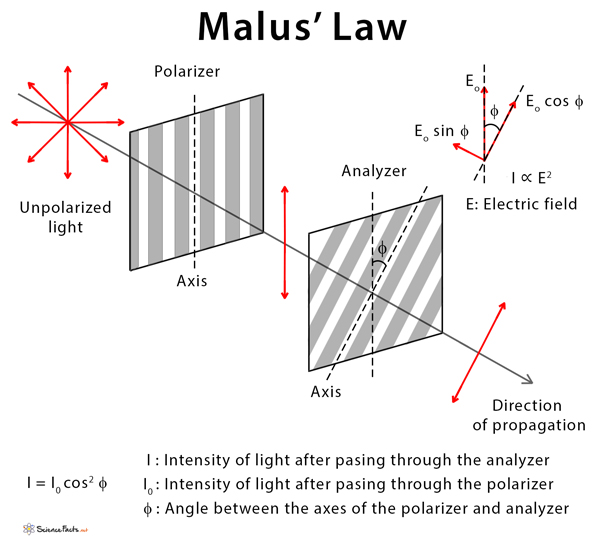Malus’ Law
What is the Malus’ Law?
Visible light is an electromagnetic wave that propagates as a transverse wave, with both the electric and magnetic fields oscillating perpendicularly to the direction of propagation. Natural light (e.g., sunlight) is unpolarized and vibrates in many directions. However, this light can be polarized by applying a filter, known as a polarizer. When a second filter is used in the path of the now polarized light, it is called an analyzer. Malus’ law states that the intensity of plane-polarized light passing through an analyzer varies as the square of the cosine of the angle between the transmission axes of the polarizer and analyzer.
Malus’ law has been named after Étienne-Louis Malus, who was a French engineer, physicist, and mathematician. Malus published his work on the polarization of light in 1809.
Malus’ Law Formula
Consider a beam of light that is polarized after passing through the polarizer, and its electric field oscillates in one plane. The axis of the polarizer lies on this plane. Let this beam be incident on an analyzer whose axis makes an angle Ø with the axis of the polarizer. The component of the electric field E in the direction of the analyzer axis is given by,
E = Eo cos Ø
Where Eo is the amplitude of the electric field vector.
This equation gives the displacement of the electric field vector after passing through the analyzer. Since the intensity I of the polarized beam is proportional to the square of the electric field, therefore,
I ∝ E2
I = Io cos2 Ø
This equation is Malus’ law.
Note that,
When Ø = 0° ( or 180° ), I = Io cos2 0° = Io. This condition implies that the intensity of light transmitted by the analyzer is maximum when the transmission axes of the analyzer and the polarizer are parallel.
When Ø = 90°, I = Io cos2 90° = 0. This condition implies that the intensity of light transmitted by the analyzer is minimum when the transmission axes of the analyzer and the polarizer are perpendicular to each other.
Applications of Malus’ Law
Malus’ law is widely used in making polaroids that are used to control the intensity of light, as in sunglasses, window panes, and sometimes photographic and 3d movie cameras.
Article was last reviewed on Friday, April 4, 2025









why cant light polariztion change by 90degrees, unless you break up the polarization in steps… eg, 10 degrees for on polairzer, etc, 10 deg, etc, 10 deg more… thus bending the polarization gradually
The polarization can change by 90 degrees if you rotate the polarizer accordingly.
Thank you. We will make the correction.